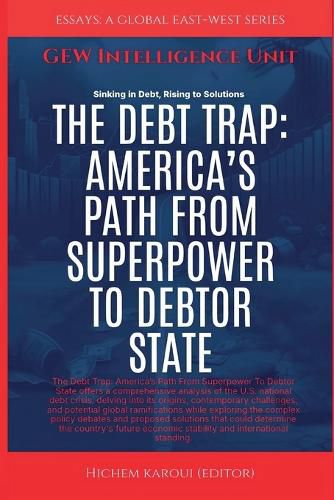Readings Newsletter
Become a Readings Member to make your shopping experience even easier.
Sign in or sign up for free!
You’re not far away from qualifying for FREE standard shipping within Australia
You’ve qualified for FREE standard shipping within Australia
The cart is loading…






This title is printed to order. This book may have been self-published. If so, we cannot guarantee the quality of the content. In the main most books will have gone through the editing process however some may not. We therefore suggest that you be aware of this before ordering this book. If in doubt check either the author or publisher’s details as we are unable to accept any returns unless they are faulty. Please contact us if you have any questions.
[The Debt Trap] examines how America reached this precarious juncture, tracing the roots of its debt crisis from the Reagan-era tax cuts and post-9/11 wars to the 2008 financial bailouts and COVID-19 stimulus packages. Both political parties share the blame: Republicans for championing deficit-busting tax breaks, Democrats for expanding entitlements without sustainable funding. The result? A debt-to-GDP ratio exceeding 120%, interest payments now outpacing defence spending, and a ticking time bomb for future generations. Yet solutions remain elusive in today's polarized climate. While economists warn of inflation spikes, currency devaluation, or even a catastrophic debt spiral, lawmakers prioritize short-term wins over long-term stability.
The book explores the global stakes-70% of U.S. debt is held domestically, but foreign creditors like China and Japan could weaponize their holdings, destabilizing markets and undermining dollar hegemony. Meanwhile, critical investments in infrastructure, education, and climate action stall as debt service consumes federal budgets. Is there a way out?
[The Debt Trap] confronts uncomfortable truths: entitlement reform, tax hikes, and spending cuts are all politically toxic. Drawing parallels to historical debt crises, from Weimar Germany to modern Greece, it asks whether America can avoid becoming a cautionary tale. The conclusion is stark: without bold action, the U.S.'s 'full faith and credit' may soon face its greatest test.
$9.00 standard shipping within Australia
FREE standard shipping within Australia for orders over $100.00
Express & International shipping calculated at checkout
This title is printed to order. This book may have been self-published. If so, we cannot guarantee the quality of the content. In the main most books will have gone through the editing process however some may not. We therefore suggest that you be aware of this before ordering this book. If in doubt check either the author or publisher’s details as we are unable to accept any returns unless they are faulty. Please contact us if you have any questions.
[The Debt Trap] examines how America reached this precarious juncture, tracing the roots of its debt crisis from the Reagan-era tax cuts and post-9/11 wars to the 2008 financial bailouts and COVID-19 stimulus packages. Both political parties share the blame: Republicans for championing deficit-busting tax breaks, Democrats for expanding entitlements without sustainable funding. The result? A debt-to-GDP ratio exceeding 120%, interest payments now outpacing defence spending, and a ticking time bomb for future generations. Yet solutions remain elusive in today's polarized climate. While economists warn of inflation spikes, currency devaluation, or even a catastrophic debt spiral, lawmakers prioritize short-term wins over long-term stability.
The book explores the global stakes-70% of U.S. debt is held domestically, but foreign creditors like China and Japan could weaponize their holdings, destabilizing markets and undermining dollar hegemony. Meanwhile, critical investments in infrastructure, education, and climate action stall as debt service consumes federal budgets. Is there a way out?
[The Debt Trap] confronts uncomfortable truths: entitlement reform, tax hikes, and spending cuts are all politically toxic. Drawing parallels to historical debt crises, from Weimar Germany to modern Greece, it asks whether America can avoid becoming a cautionary tale. The conclusion is stark: without bold action, the U.S.'s 'full faith and credit' may soon face its greatest test.